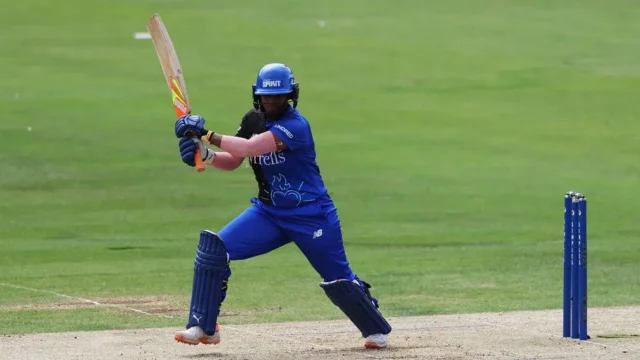The 10 Best Strategies To Create Accurate Cricket Predictions By Analyzing The Pitch Conditions And Weather Conditions
Assessing pitch and weather conditions is vital when making cricket predictions since these variables have a significant impact on the result of a game. Here are 10 suggestions to help you analyze these conditions accurately:
1. Find out more about the pitch type
Flat Pitches: Typically favor batsmen, which can lead to games with high scoring.
Green pitches: These are typically a benefit for fast bowlers since they allow an opportunity to move away from the seam.
Dusty Pitches – Surfaces which are spin-friendly. spinners will be able to benefit from the bounce and turn.
Knowing the kind of pitch will help predict the likelihood of a game ending in a low or high score, and whether batsmen (or bowlers) will dominate.
2. Look up the Historical Data
Check out past matches and see how the field has evolved over the years. Seek out trends like the amount of collapses, and specific bowler successes.
3. Consider the Season
Seasonal changes can affect weather conditions and pitches. The pitch conditions in England and in the subcontinent could be different. For instance, the pitches in England could have more seaming in the early summer, whereas the pitches in India are more spin-friendly.
4. Evaluate the First Hour of Play
The pitch can change dramatically in the initial 30 minutes of play. The morning sun can aid bowlers. In the later hours, it can help to hit. It is possible to follow live coverage of the venue, or examine previous trends.
5. Check the weather conditions
In overcast conditions, bowlers who swing will gain the most from the more air flow of their ball.
Sunny conditions: This could result in an easier ball that makes it easier to bat.
Rainy Conditions – Can disrupt the game or even reduce the number of overs. This can lead to difficult predictions.
6. Make sure you have a monitor pitch ready.
Attention to the way the pitch is prepared in the days prior to the game. Take note that thickly covered or rolling could indicate a pitch which is more conducive to batting, whereas leaving grass on the field might suggest a surface more bowler friendly.
7. Analyze Team Composition
Teams usually pick their players according to weather and pitch conditions. The pitch is likely to change direction if teams select extra spinners. If you’ve got pacers, it could mean that the pitch is likely to be green.
8. Watch out for Toss.
The toss could be vital, especially on pitches that get worse over time. Captains may decide to bat on pitches that will deteriorate or to bowl when the weather is cloudy or when seamers are dominant in the early.
9. Learn about local climate patterns
Certain venues are known for the weather conditions they have. In certain areas, the evening dew may cause difficulty to bowl in the 2nd innings.
10. Calculate the measurements of the land
Smaller pitches that have smaller borders and pitches that favour the bowlers could still be favorable to batsmen. Alternatively, a larger ground could help bowlers because it increases their margin of errors for big hits.
Combining these elements as well as information about the teams that are involved to make more accurate predictions about the cricket on the pitch and weather. View the best Free Daily Cricket Predictions for blog examples including tennis tips, bet prediction, today prediction, soccer prediction for tomorrow, nfl predictions today, tennis picks, soccer tips and predictions today, prediction s, tennis betting today, tennis predictions today and more.

Ten Suggestions For Assessing Match Conditions And Format Before Making Predictions On Cricket
In order to make accurate cricket predictions, it’s essential to assess the conditions of the game and its format. This is because different conditions and formats can dramatically influence the performance of players and teams. These 10 tips can assist you in evaluating the elements.
1. Know the Effects of Match format
Test matches: Concentrate on the endurance and technique. Be competent to play in various conditions. Teams that have a strong batsman’s depth, as well as an efficient and balanced bowling attack typically are successful.
Balance is the most important factor in ODIs. Both pitchers and batters must be able to control their own energy across 50 overs.
T20s is a high-octane and rapid-paced format where powerful, aggressive batsmen and death-bowling are vital. Teams that have versatile bowlers and explosive batsmen usually succeed.
2. Use the template provided to assess team strengths
Analyze what teams do in their respective formats. Certain teams are able to excel in Test matches because they have a strong batting line-up and a well-organized bowling attack while others are dominant in T20s for their ferocious batting style and sharp fielding.
3. Take into account players’ specific skills for the format.
There are a lot of players with particular skills that are better to be suited to specific formats. For example, some batsmen may thrive in shorter formats due to their ability to score quickly, whereas others are more successful in Tests because of their skill and endurance.
4. Review the Team’s Strategies to determine the format
Teams adopt various strategies when it comes to various formats. In T20s, for example the teams might move power hitters into the first position, whereas in ODIs it is more important to build solid foundations rather than speed.
5. Fielding Shorter Formats: Understand the importance of these formats
In T20 and ODI, fielding is even more crucial. If you can save runs by taking wickets quickly with sharp fielding, you can significantly improve your chances of success. These formats are often favoured by teams that have superior fielding.
6. Examine the impact of each format on conditions
The weather conditions and pitch conditions affect the different formats. Duckworth-Lewis for instance, can change the outcome of ODIs or T20s due to rain interruptions. Conditions that are overcast in Tests may favour seam bowlers, because they can be favored over a long period.
7. Consider Spinners’ Role in a variety of formats
Spinners are able to alter the game in any format however in different ways. In Tests, spinners could be employed for prolonged periods on pitches that are deteriorating. In T20s their usage could be during the middle of the overs when limiting the scoring rate or taking wickets.
8. The Toss is Crucial.
In cricket with limited overs, the toss is especially important. Setting or chasing goals under certain conditions can have a huge impact on the game. It is advantageous to win the toss, and bat first on a good pitch in Test matches.
9. Assess the impact of match Context
Take into consideration the context in which the match is taken place, like whether it’s part of an ongoing series knockout rounds or a game during a league. Teams could play more cautiously in a Test series opener but take a more brash strategy in a crucial T20.
10. Take into account the role of Pressure in Various Formats
Different formats impact teams in a different way. In T20s the pressure to score quick can lead to mistakes, while in Tests, sustained pressure over several sessions can be detrimental to a team. The pressure is better handled by teams with experience and those who have an excellent mental game.
If you take the time to study the structure and conditions of a match You can make more accurate predictions. View the top Cricket for blog info including nfl game predictions tonight, betting prediction sites, today prediction, nfl game today predictions, soccer predictor, nfl prediction for tonight, you betting, tips for betting today, matches and predictions, tips and predictions and more.

